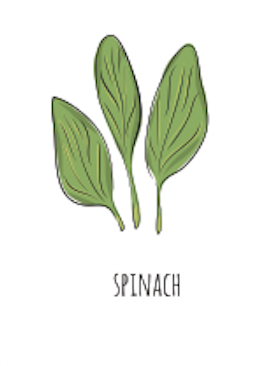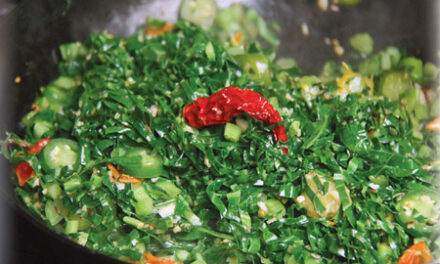
By Kendra Parker.
“Eat your greens…” is a phrase most people have heard at some point in their lives, often from Mom or Dad or perhaps Grandma and Grandpa. It can easily be pictured—a child staring into a bowl of watery iceberg lettuce heaped with gobs of bottled ranch dressing turns their gaze up and asks, “Do I have to?”
 To be fair, plenty of children are raised in households where the salads are a bit more, shall I say, inventive. Although many American households lack anything green at mealtime, save for a green pepper on a slice of deluxe pizza or a wimpy piece of lettuce on a cheeseburger. It’s ingrained in many that greens are “icky” and only for health food nuts returning home from spin class. If you’re picking up an Edible magazine, you probably don’t fit into the Standard American Diet mold and aren’t afraid of the many types of lettuce, field greens, and sprouts available. However, even if you do fit that mold, I hope to convince you that the right greens are delicious!
To be fair, plenty of children are raised in households where the salads are a bit more, shall I say, inventive. Although many American households lack anything green at mealtime, save for a green pepper on a slice of deluxe pizza or a wimpy piece of lettuce on a cheeseburger. It’s ingrained in many that greens are “icky” and only for health food nuts returning home from spin class. If you’re picking up an Edible magazine, you probably don’t fit into the Standard American Diet mold and aren’t afraid of the many types of lettuce, field greens, and sprouts available. However, even if you do fit that mold, I hope to convince you that the right greens are delicious!
In the springtime, the world begins waking back up. Trees are budding, birds are singing, and flowers begin lining our walkways. At this point in the year, I am absolutely ready for some fresh produce. Despite the season of new growth, many farmers’ markets are still shuttered. Don’t despair! Fresh local greens can be found; it just takes a little bit of indoor gardening.
I’m talking about microgreens, which just so happen to be an easy year-round crop. If you have a windowsill and can keep curious cats away, you can grow these delicious greens with very little effort. (Of course, not everyone has the time, space, or patience to grow their own food. That’s okay too. 2 Friends Farm in Attleboro or Nurcha Foods in Fall River can meet all your microgreen needs.)
 I’m getting ahead of myself. What are microgreens, you might ask? Microgreens are very close to sprouts. There are two key differences between sprouts and microgreens. Sprouts are exclusively grown hydroponically, and the entire sprout is consumed—seed, root, stem, and leaves. Microgreens can be planted in soil or grown hydroponically and are cut off at the root. Only the stem and leaves are consumed. They also have a slightly longer harvest time. Microgreens are absolutely packed with nutrients in comparison with sprouts as well—up to forty times what is found in a fully developed plant or vegetable. They make a fantastic salad, a great topping for a burger or sandwich, or a nice-looking garnish.
I’m getting ahead of myself. What are microgreens, you might ask? Microgreens are very close to sprouts. There are two key differences between sprouts and microgreens. Sprouts are exclusively grown hydroponically, and the entire sprout is consumed—seed, root, stem, and leaves. Microgreens can be planted in soil or grown hydroponically and are cut off at the root. Only the stem and leaves are consumed. They also have a slightly longer harvest time. Microgreens are absolutely packed with nutrients in comparison with sprouts as well—up to forty times what is found in a fully developed plant or vegetable. They make a fantastic salad, a great topping for a burger or sandwich, or a nice-looking garnish.
Several years back I had the pleasure of meeting Peter Burke, author of Year-round Indoor Salad Gardening. I attended a workshop he hosted on growing microgreens and was able to chat with him for a while afterward. Having been so pleased with his presentation, I purchased a copy of his book and invited him to present at a conference my then-employer was hosting. As I read through the book, I realized that growing greens was a lot easier than I had previously thought! Though some folks use grow lights, his simpler methods are both effective and affordable and are what I’ll be sharing with you here.
Start Small

First and foremost, start small. It’s never a good idea to buy tons of equipment, pots, and an excessive number of seeds for a new enthusiasm without at least trying it out first. Give yourself time to experiment and find out what works for you. In my experience, what does not work is a microgreen fish tank. They’re gimmicky and don’t work very well. My husband purchased one for me years ago and it seemed like a fantastic idea and very cute, but it was not very effective. The seeds are planted among rocks and don’t grow evenly. Because they’re sitting in a wet fish tank, the greens easily grow moldy. It’s a great idea in theory, but the execution doesn’t really work.
The Equipment
To begin this more effective method, you will need containers for growing (small aluminum bread pans are great for first-timers), good soil, paper towels, and seeds. Any vegetable potting soil is fine, but if you can find one with kelp, perlite, and natural fertilizers, you’ll likely have a better crop. Coast of Maine has some excellent soils and composts. What seeds you grow is totally a matter of choice, but beets, basil, broccoli, kale, radish, and sunflower are a few great options.
The Seeds

If starting with just one tray, you’ll only need one or two tablespoons of seeds. Put the seeds in a small cup and cover with water, and soak for six hours or overnight. After your seeds have soaked, gather enough soil to fill your bread pan (about two cups dry), and moisten it well in a bowl. Feel free to mix in a spoon or two of compost for healthier soil. Once wet, place the soil in the pan, leaving about ¼ inch of headspace. Drain your seeds in a fine-mesh colander and then spread seeds over the soil so they are covering the surface, but not overlapping. Wet a paper towel or two and then fold it in half once or twice. Place this towel on top of your pan, so it covers and touches the seeds. Put the pan in a warm, dark place for four days. On day five, remove the paper towel, water the tray, and place it on a windowsill.
Care
Water the tray once a day, and don’t let the soil dry out. When watering, be careful not to disturb the seeds sitting on the soil. A small indoor watering can with the spout pointed close to the surface works well. Your crop will be ready for harvest in three to seven days, depending on the light and heat in your home. Greens can be harvested with scissors.
That’s it! It’s incredibly simple and rewarding. I highly recommend Burke’s book if you’re interested in learning more about growing your own microgreens. I provided a quick down and dirty, but he goes a lot more in-depth with growing methods, seed selection, and harvest and storage. Here’s to eating your greens!







